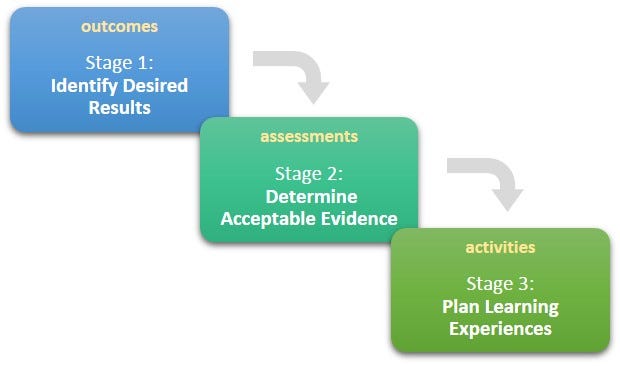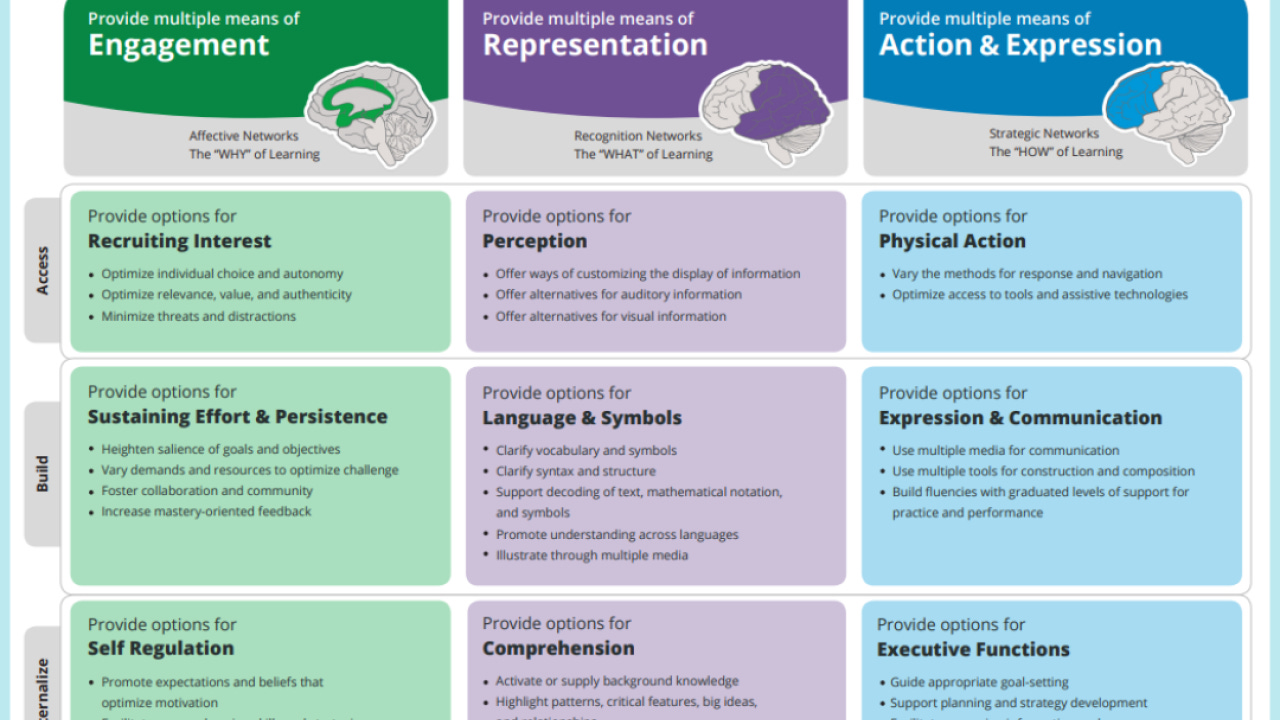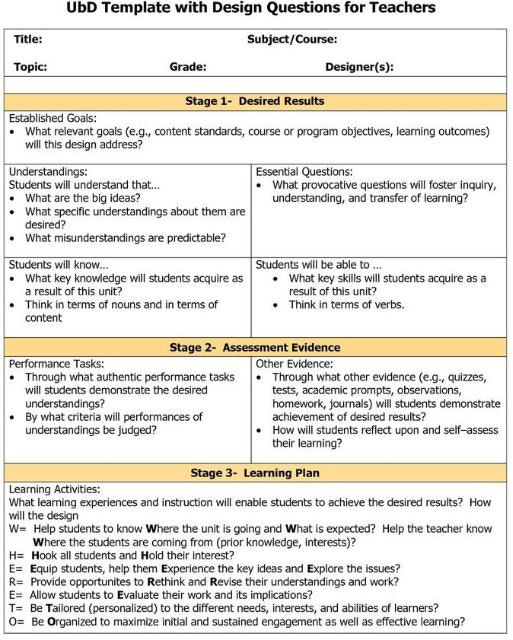From Understanding by Design (UbD) to Universal Design of Learning (UDL): A comparative analysis of design frameworks for teaching diverse K-10 learners
Pratyay Malakar
Introduction
Understanding by Design (UbD) and Universal Design of Learning (UDL) are two instructional design frameworks that have been developed to help teachers design effective lessons and assessments for a diverse range of learners. Both frameworks are widely used in K-10 classrooms and share many similarities. However, there are also some important differences between the two approaches. This article will explore the UbD and UDL frameworks and compare their features, benefits, and limitations, focusing on teaching diverse K-10 learners.
Why do we need to use frameworks as teachers?
Fostering teacher thinking through design frameworks is an essential component of effective teaching. As teachers, we often face a variety of challenges in the classroom, from diverse student, needs to the demands of the curriculum. Design frameworks such as UbD and UDL provide a structure for teachers to think more deeply about their teaching practices and create meaningful, effective instruction that meets the needs of all learners. By using these frameworks, teachers can develop a more comprehensive understanding of their teaching goals, plan for diverse student needs, and create inclusive learning environments.
However, it's important to understand each framework's purpose, stages, benefits, and limitations to use them effectively. Understanding each framework's strengths and weaknesses can help teachers make informed decisions about which framework to use in their teaching practice. By integrating both UbD and UDL into teaching practice, educators can create a learning environment that is not only accessible and engaging for all students but also prepares them for success in a diverse and ever-changing world.
Understanding by Design (UbD)
UbD is an instructional design framework that Grant Wiggins and Jay McTighe in the late 1990s developed. The framework is based on the idea that effective teaching and learning should be driven by clear goals and objectives, meaningful assessment, and instructional strategies that support student learning. The UbD framework is a three-stage process that begins with identifying desired outcomes, moves on to designing assessments to measure those outcomes, and ends with planning instruction that supports student achievement of those outcomes.
Stage 1: Identify Desired Outcomes
The first stage of the UbD framework involves identifying what students should know, understand, and be able to do at the end of the unit or lesson. This is done by creating clear learning objectives aligned with standards and written in student-friendly language. The objectives should be specific, measurable, and achievable.
Stage 2: Design Assessments
The second stage of the UbD framework involves designing assessments that align with the identified outcomes. Assessments should be authentic and varied, reflecting real-world scenarios and providing multiple ways for students to demonstrate their understanding. The assessments should also align with the learning objectives and provide feedback to students and teachers.
Stage 3: Plan Instruction
The third stage of the UbD framework involves planning instruction that supports student achievement of the identified outcomes. This includes designing learning activities that are engaging, meaningful, and relevant to students’ lives. The instruction should also provide multiple opportunities for students to practice and apply their learning, and it should be differentiated to meet the needs of diverse learners.
Benefits and Limitations of UbD
The benefits of the UbD framework include its focus on clear learning objectives, authentic assessments, and differentiated instruction. This helps ensure that students are actively engaged in learning and have multiple opportunities to demonstrate their understanding. Additionally, the UbD framework emphasizes the importance of alignment between learning objectives, assessments, and instruction, which can improve the quality and effectiveness of instruction.
However, the UbD framework has some limitations. Developing clear learning objectives and assessments that align with standards and are relevant to students’ lives can be time-consuming. Additionally, the framework does not explicitly address the needs of students with disabilities or other special needs, which can make it challenging to meet the needs of all learners.
Universal Design of Learning (UDL)
UDL is an instructional design framework that was developed by the Center for Applied Special Technology (CAST) in the 1990s. The framework is based on the idea that effective instruction should be accessible to all learners, regardless of their backgrounds, abilities, or disabilities. UDL emphasizes the importance of designing flexible, responsive, and engaging instruction for all learners.
UDL has three main principles:
Multiple Means of Representation: This principle involves providing multiple ways for students to access information and content. This can include using visual aids, providing text-to-speech options, and providing content in multiple formats.
Multiple Means of Action and Expression: This principle involves providing multiple ways for students to demonstrate their understanding and express their ideas. This can include providing options for students to use different modes of expression (e.g. written, oral, visual), opportunities for students to work collaboratively, and opportunities for students to use different tools and technologies to demonstrate their learning.
Multiple Means of Engagement: This principle involves providing multiple ways to engage students in learning. This can include using real-world scenarios and examples, providing opportunities for student choice and autonomy, and incorporating student interests and passions into the learning experience.
Benefits and Limitations of UDL:
The benefits of UDL include its emphasis on designing instruction that is accessible to all learners, regardless of their backgrounds or abilities. By providing multiple means of representation, action and expression, and engagement, UDL can help ensure that all students have equal access to the curriculum and are able to demonstrate their understanding in meaningful ways. Additionally, UDL encourages teachers to be creative and flexible in their instructional design, which can increase student engagement and motivation.
However, there are also some limitations to UDL. Implementing UDL can be challenging, as it requires significant time and effort to design instruction that is truly accessible to all learners. Additionally, UDL may not be sufficient on its own to meet the needs of students with severe disabilities or other complex needs, which may require more specialized support and services.
Comparative Analysis of UbD and UDL:
While UbD and UDL share some similarities, such as their focus on clear learning objectives and their emphasis on engaging, student-centered instruction, there are also some key differences between the two frameworks.
One of the main differences is the emphasis on accessibility and inclusivity. While UbD does address differentiation, it does not explicitly focus on designing instruction that is accessible to all learners. UDL, on the other hand, emphasizes the importance of designing flexible instruction that is responsive to the diverse needs of learners, including those with disabilities and other special needs.
Another key difference is the focus on assessment. While UbD emphasizes the importance of designing assessments that align with learning objectives, UDL takes a broader view of assessment, emphasizing the importance of ongoing, formative assessment that helps teachers adjust instruction to meet the needs of diverse learners.
Finally, there is a difference in the level of detail and specificity provided by each framework. UbD provides a detailed, step-by-step process for designing instruction that is aligned with learning objectives and assessments. UDL, on the other hand, provides a broader set of principles and guidelines for designing instruction that is accessible and engaging for all learners, but does not provide as much specific guidance on how to implement these principles in practice.
Implications for Teaching Diverse K-10 Learners:
Both UbD and UDL have important implications for teaching diverse K-10 learners. By emphasizing the importance of clear learning objectives, authentic assessments, and engaging instruction, both frameworks can help ensure that all students are actively engaged in the learning process and have multiple opportunities to demonstrate their understanding.
For teachers who are looking to design instruction that is truly accessible and inclusive, UDL may be the better choice. UDL's emphasis on flexibility, responsiveness, and multiple means of representation, action and expression, and engagement can help ensure that all learners have equal access to the curriculum and are able to participate in meaningful ways.
However, it is also important to recognize that implementing UDL can be challenging and time-consuming, and may require additional training and resources. For teachers who are just starting out with instructional design, or who have limited resources, UbD may be a more practical option.
Ultimately, the choice between UbD and UDL will depend on the learners' specific needs and the classroom's resources and constraints. Both frameworks have their strengths and limitations, and teachers will need to consider these factors when designing instruction for their students carefully.
Bringing UbD and UDL Frameworks together to reach all learners:
Incorporating both UbD and UDL together in lessons can help teachers design instruction that is both engaging and accessible for all learners. Here are some steps that teachers can take to incorporate both frameworks in their lessons:
Incorporating both Understanding by Design (UbD) and Universal Design for Learning (UDL) can lead to more effective and inclusive teaching practices. Here are some action steps for teachers and teacher coaches to integrate these frameworks into their teaching practice:
For Teachers:
Attend professional development: Attend professional development opportunities to understand better UbD and UDL and how they can be applied to your teaching practice.
Develop inclusive lesson plans: Incorporate both UbD and UDL principles into your lesson plans by identifying learning goals, assessments, and planning for multiple means of representation, action, and engagement.
Reflect and adjust: Reflect on the effectiveness of your lesson plans and adjust them accordingly. Continuously seek student feedback to ensure the lesson plans meet their diverse needs.
For Teacher Coaches:
Provide professional development opportunities: Offer professional development opportunities to teachers on UbD and UDL, and provide support during implementation.
Observe and provide feedback: Observe teachers' lessons and provide feedback on how they can further integrate UbD and UDL principles into their teaching practice.
Collaborate with teachers: Work collaboratively to develop inclusive lesson plans that incorporate UbD and UDL principles. Encourage teachers to reflect on the effectiveness of their lesson plans and provide support in making necessary adjustments.
By integrating both UbD and UDL into teaching practice, educators can create a learning environment that is not only accessible and engaging for all students but also prepares them for success in a diverse and ever-changing world. It is essential that we as educators continue to learn, reflect, and adapt our practices to meet the diverse needs of all learners. Doing so can create a more inclusive and equitable educational experience for all.
Resources:
Here are UDL and UbD Checklists for your reference.
You can also explore Design Templates for UDL Lesson and UbD Lesson
References:
Erickson, H., & Noonan, P. (2017). Concept-Based Curriculum and Instruction for the Thinking Classroom. Thousand Oaks, CA: Corwin.
McTighe, J., & Wiggins, G. (2005). Understanding by Design. Alexandria, VA: Association for Supervision and Curriculum Development.
Rose, D. H., & Meyer, A. (2002). Teaching Every Student in the Digital Age: Universal Design for Learning. Alexandria, VA: Association for Supervision and Curriculum Development.
Tomlinson, C. A., & McTighe, J. (2006). Integrating Differentiated Instruction and Understanding by Design: Connecting Content and Kids. Alexandria, VA: Association for Supervision and Curriculum Development.









